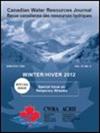Testing a modified environmental flows framework for a Southern Ontario (Canada) river system: assessing hydrological alteration and management recommendations
IF 0.9
4区 环境科学与生态学
Q3 WATER RESOURCES
引用次数: 0
Abstract
Abstract To date, environmental flow strategies have predominantly been used in cases where a lack of available water has degraded the ecological quality and natural functioning of a river system. In this study, we used environmental flows on an urbanized watershed where flow volumes and flow rates have increased, and large (e.g. 100-year) event return periods become more frequent (∼10 years). Using an environmental flows strategy to model the amount of hydrological alteration, we assessed whether urban development and land cover changes have impacted the flow regime and the ecological health of this watershed. We reconstructed the flow regime at Lovers Creek (Barrie, Ontario, Canada) using three scenarios of urban development: a pre-settlement reference condition with 100% natural cover, mid-development with 6% urban cover and the current condition with 21% urban cover. We found that, in contrast to many other studies, increased urban cover has coincided with increased baseflow volumes, as well as increased volumes in other components of the flow regime. Of particular concern were the increased flow rate and volume of large events such as channel forming and riparian flows; an increased rate of change in event hydrographs, and a much shorter return period of large event storms (e.g. a 100-year event under reference conditions, is now a 10-year event in the current urbanized condition). In this watershed, restoration of flow to the reference condition is not practical; however, using improved stormwater management such as low-impact development technologies and green infrastructure may offset some of the alteration to the flow regime and mitigate future further alterations due to increased urbanization. As Lovers Creek has been identified as a critical coldwater stream habitat with brook trout, the results of this study are being used to assess changes in the ecological health due to increased urban cover, and to develop management strategies that assist in restoring a more natural flow regime in order to better protect both natural habitats and human infrastructure that are vulnerable to flooding caused by more frequent, increased volume flow events.测试修改后的南安大略(加拿大)河流系统环境流动框架:评估水文变化和管理建议
迄今为止,环境流量策略主要用于缺乏可用水导致河流系统生态质量和自然功能退化的情况。在本研究中,我们使用了一个城市化流域的环境流,该流域的流量和流速都有所增加,大(例如100年)的事件返回周期变得更加频繁(~ 10年)。利用环境流量策略来模拟水文变化的数量,我们评估了城市发展和土地覆盖变化是否影响了该流域的流量状况和生态健康。我们使用三种城市发展情景重建了恋人溪(加拿大安大略省巴里市)的流量状况:定居前参考条件下100%的自然覆盖、开发中期6%的城市覆盖和目前21%的城市覆盖。我们发现,与许多其他研究相反,城市覆盖面积的增加与基流体积的增加以及流态其他组成部分的体积增加相吻合。特别值得关注的是,河道形成和河岸流动等大型事件的流速和体积增加;事件水文变化率增加,大事件风暴的回复期大大缩短(例如,参考条件下的100年事件,在当前城市化条件下现在是10年事件)。在该流域,将流量恢复到参考状态是不现实的;然而,使用改进的雨水管理,如低影响开发技术和绿色基础设施,可能会抵消一些对水流状况的改变,并减轻未来因城市化增加而进一步变化的影响。由于恋人溪已被确定为布鲁克鳟鱼的重要冷水流栖息地,本研究的结果被用于评估由于城市覆盖面积增加而导致的生态健康变化,并制定管理策略,以帮助恢复更自然的流量制度,以便更好地保护自然栖息地和人类基础设施,这些设施容易受到更频繁,更大的流量事件引起的洪水的影响。
本文章由计算机程序翻译,如有差异,请以英文原文为准。
求助全文
约1分钟内获得全文
求助全文
来源期刊

Canadian Water Resources Journal
WATER RESOURCES-
CiteScore
2.90
自引率
5.90%
发文量
17
审稿时长
>12 weeks
期刊介绍:
The Canadian Water Resources Journal accepts manuscripts in English or French and publishes abstracts in both official languages. Preference is given to manuscripts focusing on science and policy aspects of Canadian water management. Specifically, manuscripts should stimulate public awareness and understanding of Canada''s water resources, encourage recognition of the high priority of water as a resource, and provide new or increased knowledge on some aspect of Canada''s water.
The Canadian Water Resources Journal was first published in the fall of 1976 and it has grown in stature to be recognized as a quality and important publication in the water resources field.
 求助内容:
求助内容: 应助结果提醒方式:
应助结果提醒方式:


